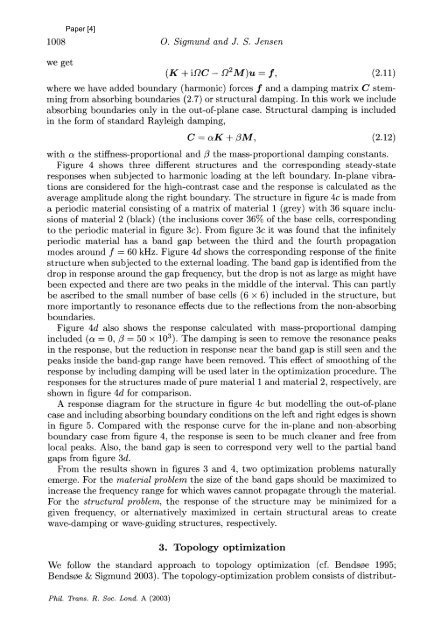WAVES AND VIBRATIONS IN INHOMOGENEOUS STRUCTURES ...
WAVES AND VIBRATIONS IN INHOMOGENEOUS STRUCTURES ...
WAVES AND VIBRATIONS IN INHOMOGENEOUS STRUCTURES ...
Create successful ePaper yourself
Turn your PDF publications into a flip-book with our unique Google optimized e-Paper software.
1008<br />
O. Sigmund and J. S. Jensen<br />
we get<br />
(K + i2C - 22M)u = f, (2.11)<br />
where we have added boundary (harmonic) forces f and a damping matrix C stemming<br />
from absorbing boundaries (2.7) or structural damping. In this work we include<br />
absorbing boundaries only in the out-of-plane case. Structural damping is included<br />
in the form of standard Rayleigh damping,<br />
C =aK + 3M, (2.12)<br />
with a the stiffness-proportional and / the mass-proportional damping constants.<br />
Figure 4 shows three different structures and the corresponding steady-state<br />
responses when subjected to harmonic loading at the left boundary. In-plane vibra-<br />
tions are considered for the high-contrast case and the response is calculated as the<br />
average amplitude along the right boundary. The structure in figure 4c is made from<br />
a periodic material consisting of a matrix of material 1 (grey) with 36 square inclu-<br />
sions of material 2 (black) (the inclusions cover 36% of the base cells, corresponding<br />
to the periodic material in figure 3c). From figure 3c it was found that the infinitely<br />
periodic material has a band gap between the third and the fourth propagation<br />
modes around f = 60 kHz. Figure 4d shows the corresponding response of the finite<br />
structure when subjected to the external loading. The band gap is identified from the<br />
drop in response around the gap frequency, but the drop is not as large as might have<br />
been expected and there are two peaks in the middle of the interval. This can partly<br />
be ascribed to the small number of base cells (6 x 6) included in the structure, but<br />
more importantly to resonance effects due to the reflections from the non-absorbing<br />
boundaries.<br />
Figure 4d also shows the response calculated with mass-proportional damping<br />
included (a = 0, 3 = 50 x 103). The damping is seen to remove the resonance peaks<br />
in the response, but the reduction in response near the band gap is still seen and the<br />
peaks inside the band-gap range have been removed. This effect of smoothing of the<br />
response by including damping will be used later in the optimization procedure. The<br />
responses for the structures made of pure material 1 and material 2, respectively, are<br />
shown in figure 4d for comparison.<br />
A response diagram for the structure in figure 4c but modelling the out-of-plane<br />
case and including absorbing boundary conditions on the left and right edges is shown<br />
in figure 5. Compared with the response curve for the in-plane and non-absorbing<br />
boundary case from figure 4, the response is seen to be much cleaner and free from<br />
local peaks. Also, the band gap is seen to correspond very well to the partial band<br />
gaps from figure 3d.<br />
From the results shown in figures 3 and 4, two optimization problems naturally<br />
emerge. For the material problem the size of the band gaps should be maximized to<br />
increase the frequency range for which waves cannot propagate through the material.<br />
For the structural problem, the response of the structure may be minimized for a<br />
given frequency, or alternatively maximized in certain structural areas to create<br />
wave-damping or wave-guiding structures, respectively.<br />
3. Topology optimization<br />
We follow the standard approach to topology optimization (cf. Bends0e 1995;<br />
Bends0e & Sigmund 2003). The topology-optimization problem consists of distribut-<br />
Phil. Trans. R. Soc. Lond. A (2003)

















